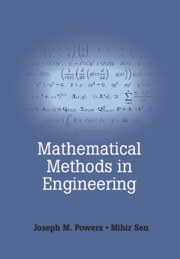Book contents
- Frontmatter
- Dedication
- Contents
- Preface
- 1 Multivariable Calculus
- 2 Vectors and Tensors in Cartesian Coordinates
- 3 First-Order Ordinary Differential Equations
- 4 Linear Ordinary Differential Equations
- 5 Approximation Methods
- 6 Linear Analysis
- 7 Linear Algebra
- 8 Linear Integral Equations
- 9 Dynamical Systems
- Appendix A
- References
- Index
5 - Approximation Methods
Published online by Cambridge University Press: 05 February 2015
- Frontmatter
- Dedication
- Contents
- Preface
- 1 Multivariable Calculus
- 2 Vectors and Tensors in Cartesian Coordinates
- 3 First-Order Ordinary Differential Equations
- 4 Linear Ordinary Differential Equations
- 5 Approximation Methods
- 6 Linear Analysis
- 7 Linear Algebra
- 8 Linear Integral Equations
- 9 Dynamical Systems
- Appendix A
- References
- Index
Summary
This chapter deals with approximation methods, mainly through the use of series. After a short discussion of approximation of known functions, we focus on approximately solving equations for unknown functions. One might wonder why anyone should bother with an approximate solution in favor of an exact solution. There are many justifications. Often physical systems are described by complicated equations with detailed exact solutions; the details of the solution may in fact obscure easy interpretation of results, rendering the solution to be of small aid in discerning trends or identifying the most important causal agents. A carefully crafted approximate solution will often yield a result that exposes the important driving physics and filters away extraneous features of the solution. Colloquially, one hopes for an approximate solution that segregates the so-called signal from the noise. This can aid the engineer greatly in building or reinforcing intuition and sometimes lead to a more efficient design and control strategy. In other cases, including those with practical importance, exact solutions are not available. In such cases, engineers often resort to numerically based approximation methods. Indeed, these methods have been established as an essential design tool; however, short of exhaustive parametric studies, it can be difficult to induce significant general insight from numerics alone. Numerical approximation is a broad topic and is not is studied here in any real detail; instead, we focus on analysis-based approximation methods. They do not work for all problems, but in those cases where they do, they are potent aids to the engineer as a predictive tool for design.
Often, though not always, approximation methods rely on some form of linearization to capture the behavior of some local nonlinearity. Such methods are useful in solving algebraic, differential, and integral equations. We begin with a consideration of Taylor series and the closely related Padé approximant. The class of methods we next consider, power series, employed already in Section 4.4 for solutions of ordinary differential equations, is formally exact in that an infinite number of terms can be obtained. Moreover, many such series can be shown to have absolute and uniform convergence properties as well as analytical estimates of errors incurred by truncation at a finite number of terms.
- Type
- Chapter
- Information
- Mathematical Methods in Engineering , pp. 219 - 278Publisher: Cambridge University PressPrint publication year: 2015



